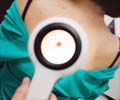Ultraviolet radiation from the sun has been proven to cause melanoma.

‘Melanoma survivors are more likely to limit sun exposure than people who had never had the disease, but some still reported seeking out suntans and getting sunburns.’





Survivors of melanoma were more likely to limit exposure to the sun
than people who had never had the disease, but some still reported
seeking out suntans and getting sunburns.The findings are published in the Cancer Epidemiology, Biomarkers & Prevention, a journal of the American Association for Cancer Research.
Rachel Isaksson Vogel, an assistant professor in the Department of Obstetrics, Gynecology and Women's Health at the University of Minnesota and colleagues compared sun exposure and protection behaviors in long-term melanoma survivors with those who had never had the disease, asking participants about the amount of time they had spent outdoors in the summer, and about sun protection methods such as wearing sunscreen, staying in the shade, wearing hats, and intentionally tanning.
Participants were also asked to report the number of red or painful sunburns they had experienced in the past year, and whether they had used a tanning bed or booth in the past year.
The study comprised 724 melanoma survivors and 660 controls. All were between the ages of 25 and 59, and the survivors had been diagnosed with invasive cutaneous melanoma between July 2004 and December 2007.
Advertisement
- 34.3% of survivors spent more than an hour outside on summer weekdays, compared with 44.4% of controls;
- 19.5% of survivors said they had gotten a sunburn in the previous year, compared with 36.5% of controls;
- 1.7% of survivors said they had used a tanning booth or bed in the previous year, compared with 6.8% of controls; and
- 61.9% of survivors often or always wore sunscreen, compared with 38.4% of controls.
Advertisement
"At a time when rates of many cancer types are declining, the rising incidence of melanoma is worrisome," Vogel said. "People who have survived melanoma are at high risk of another diagnosis, so reducing exposure to the sun is really crucial."
Vogel said that in conversations with individuals diagnosed with melanoma, many survivors expressed a desire to "just live their lives," playing with their children, exercising, and socializing outdoors. She said that in most cases, the participants had been diagnosed with stage 1 disease, when melanoma is often easily treated and has a five-year survival rate of 98%.
"Because an early-stage melanoma diagnosis and treatment was likely a fairly minor experience for most survivors, they might not understand how serious an illness this is," Vogel said. "Survivors of melanoma have a nearly nine-fold risk of developing melanoma again, and they can reduce that risk if they make sun protection a priority."
Vogel noted that one limitation of the study is that data on second primary melanomas - a new diagnosis at a different site than the initial diagnosis - were not available for all participants. Also, she said, it is possible that some subjects over-reported their sun protection behaviors.
Source-Eurekalert













